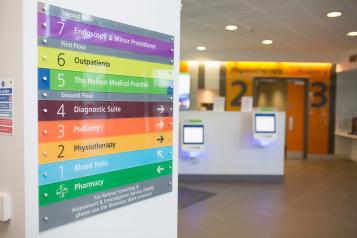A response to the Future Fit consultation by the HWT&W Board

Introduction
The Future Fit process started about 4 years ago with an NHS conference at the International Conference Centre which was intended to be a “Call to Action” and at which generally all attendees agreed that some form of change was required to effect improvements to Health and Social Care provision in Shropshire and Telford & Wrekin.
Subsequently, Healthwatch Telford and Wrekin (HWT&W) has been involved in all stages of Future Fit (FF) as the programme gained momentum. This work has included the monthly meetings of the Programme Board, various Option Appraisal sessions, Risk Reviews and Clinical Commissioning Group (CCG) events.
The process has been largely driven by a FF Team and the two Accountable Officers using CCG Staff and more recently has been subsumed into part of the Sustainability and Transformation Partnership (STP) process.
Ultimately the direction of travel for FF has been underpinned by the report from the Clinical Working Group in 2016 and perhaps a less than informed assessment of the modeling by KPMG. Unsurprisingly, Consultants and Doctors like to see the collocation and grouping of key elements of clinical services. Thus to a great extent the clinical staff have seemingly been loyal to the Trauma-centre model which is currently based on the Royal Shrewsbury Hospital (RSH).
Consultation
HWT&W have been more than happy to facilitate throughout the consultation process, remaining as an Independent body ensuring that the local Community is informed and with HWTW not subscribing to a particular viewpoint or FF option. HWT&W has also distributed the FF documents and survey forms throughout Telford and Wrekin (T&W) and it is heartening to learn that at the time of writing over 14,000 responses have been received by the FF team which is an excellent result when compared with the national average for public consultations.
That said, we are now coming to the end of the consultation period and we advised the FF Programme at the outset that HWT&W would submit a unified response from the organization prior to the 11th September end date.
The rest of this paper pulls in the views of our Community and is intended to be a HWT&W objective commentary on the FF Options.
Demographics
Whatever the solution selected for SaTH, it must be predicated on future statistics and have the longevity to serve the county for the next 30 years or more. The T&W population is around 175,271 (2017) and forecast to grow in the next 15 years to around 196,855. T&W is also a young conurbation with the number of households with dependent children being some 33.0% against an average in England of 29.1%. There is also a natural locus to the much newer Princess Royal Hospital (PRH) Telford, of the surrounding East Shropshire and even West Staffordshire populations such as Albrighton, Broseley, Market Drayton, Shifnal and Bridgnorth which currently add over 41,000 to a population looking for a conveniently located Hospital and this slice of the populace is set to grow to well over 50-60,000 with local developments such as those planned in Tong (circa 10,000 houses). These additional numbers need to be factored into the options assessment in a meaningful way instead of lumping them all into the Shropshire pot.
In the wider Shropshire the number of over 50 year olds is 44% which is higher than the average in England of 36.4%. With an ever increasing and much younger population in T&W rather than Shropshire, there is a strong, compelling argument to retain the existing and relatively new clinician led Mothers and Children’s unit at PRH. Clearly from your own clinical studies it also makes sense to collocate the “blue light” A&E facility at the same hospital which might therefore lead to a different set of options.
We have not commented on Travel & Transportation as the work in this area is on-going, however it is a frequent issue of concern raised by our Community, especially the deprived and vulnerable. This may have a significant impact on the costs of whichever option is selected, particularly in the wider Shropshire and Powys areas.
Income Drift
One area that HWT&W feel the FF team have not properly considered is the potential income drift (funding follows the patient) that both Options are likely to generate. If one looks at the separation of A&E and Planned Care which is the core premise of FF; dependant on the option selected, there is likely to be income drift from East Shropshire towards Stafford, Wolverhampton and even Stoke. In South Shropshire that drift will be towards Worcester or Hereford . In Powys, particularly encouraged by the “People of Powys First” and “Powys Pound” policies, adopted in 2017 after the main FF appraisal work, there is likely to be income drift to Wrexham and Aberystwyth. It should also be remembered that the SaTH income from Powys is some 10% of the total annual income. The other element with regards to Powys the availability of the Emergency Medical Retrieval and Transfer Service in Wales (EMRTS Cymru) which only operates in Wales and would obviate the need to use an A&E based in Shropshire. HWT&W would have liked to have seen more detail provided in terms of the potential downside of the options which when married with the analysis of demographics and improving medical provision in Powys, might lead to a reassessment of the selected option.
Staffing
Notwithstanding the current staffing problems, which makes SaTH extremely fragile, the FF programme assumes a reduction in overall staff numbers of some 7% although the FF documentation does not reveal any such decrease in numbers. The SaTH annual report 2017/18 shows 5515 Whole Time Equivalents (WTE) whereas the FF staffing position is roughly 5035 WTEs a reduction of 480 or about 9%. That would be fine if the workload was also reducing, however it would appear from the FF Consultation document that there will be at least a 12% increase in workload through the increase in hospital beds. These numbers are not compatible, suggesting a productivity improvement in the order of 13.8% which gives HWT&W some problem in accepting that this is actually achievable given that the staff is already working hard to provide a good level of care. Productivity is not a concept that is fully understood by the NHS although many of the softer solutions are already being introduced within SaTH, even so, research by the Office of Budget Responsibility indicates that any productivity increase above 2.5 – 3% would be an excellent achievement. All of this suggests that the staff numbers will have to be increased which in turn, places additional stress on the financial model and probably less capital spend on refurbishment activity.
Integrated Care System
Another dimension that needs to be woven into the future of Health and Social Care in Shropshire and hence FF, is the dimension of Community Health. Currently Shropshire has a network of Community Hospitals and care in addition to the RSH, which are a significant ingredient in the strategic NHS initiatives of “Care in the Community” and the “Prevent” agenda. If this is taken to its desired outcome the reduction in demand on acute services will be significantly decreased. SaTH cannot be refreshed for the future as part of an Integrated Care System (ICS) unless all the elements are considered in concert. No extensive consideration of this future collaborative environment has been made in the FF process.
Conclusion
In the light of the above considerations and the need to move forward with a more holistic approach as Shropshire contemplates the construction of an ICS, HWT&W believe that a demand based assessment should prevail. Our feeling is that there is a strong rationale for selecting Option 2.
David Lister Brown
On Behalf of the Healthwatch Telford and Wrekin Board
10th September 2018
